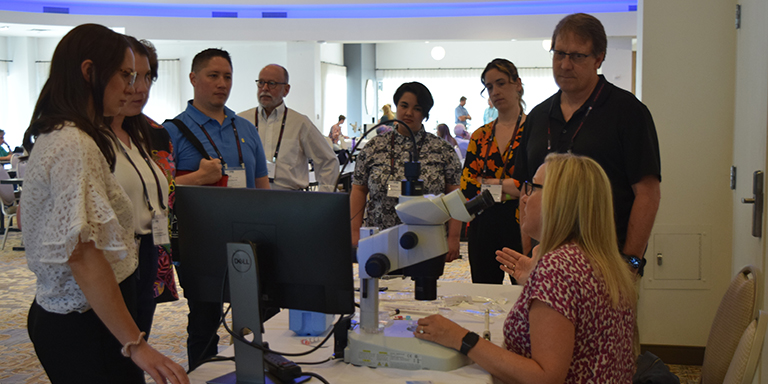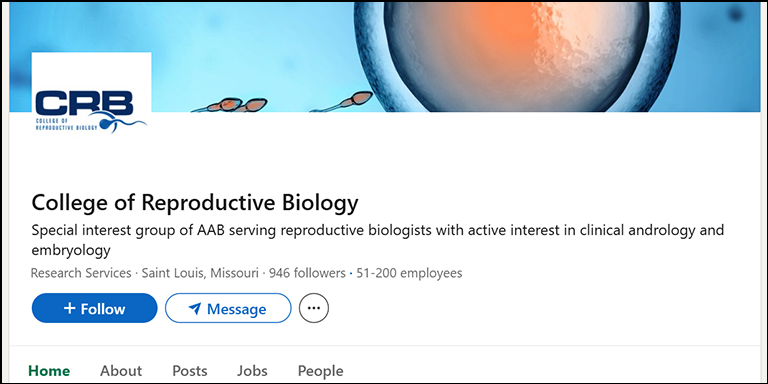
Newsletter
The College of Reproductive Biology (CRB) is a not-for-profit special interest group of the American Association of Bioanalysts (AAB).
Artificial Intelligence: The Question Is Not If We Should Use It, But How We Use It Responsibly
Sam Prien, Ph.D., HCLD(ABB)
The last few years have seen an intense interest in artificial intelligence (AI) from all sectors of society. Our own field has been abuzz with potential uses for AI from dish preparation to sperm selection, even performing the routine parts of fertilization and embryo culture, and potentially choosing the embryos for transfer.
Some argue AI can never perform the work as well as a human embryologist/andrologist. Others argue AI is the future and to not embrace is to be left behind. I would encourage all to take a deep breath and a step back to evaluate AI as it currently exists, its benefits, its limitations and even its potential risk to our advancement.
Artificial intelligence is truly being incorporated into almost every aspect of human existence. First recognize it for what it is, a new technology, nothing more and nothing less. Its successful and proper use will not be dependent on its own independent actions, but in partnership with us. Why, at least at its current level of existence, AI is incapable of independent creative thought. It needs human input and questioning to “know” what data to examine and the correlation to look at. It currently is only capable of only looking at those things. In computer science and research there is an axiom, “garbage in garbage out.1” In other words AI can only be as good as it is taught. Further, for any AI system to be effective you need huge and multiple data sets for training. While studies with subject matter in hundreds may be suggestive, for AI to be truly reliable, it needs multiple data sets in the thousands to begin to “learn” what is “good” and “bad.”2-3
Further, it needs diversity of input. For example, having a single individual teach AI embryo grading using thousands of embryos, is not as effective as having multiple embryologists providing input on say the same 500 embryos. By being exposed to multiple trainers, AI can “learn” the nuances of embryology.4
Artificial Intelligence and its associated instrumentation can also take over a number of routine tasks in the laboratory. It might even be able to detect issues before they can be identified as an issue by humans.
All of these are positive things for our industry and other industries and we should embrace the assistance with open arms.
However, there are also risks associated with AI. One of the greatest risks it presents to us is the great potential for it to take the place (notice I said take the place, not replace) of human critical thinking5. As we embrace AI, we must never forget it is a tool. It is not meant to replace human thought, as I said earlier, at least in its present form it cannot initiate a de novo idea without human input. But as an educator, here is where I see the risk. Artificial intelligence is an aphrodisiac for the human mind. It is a powerful tool that can be abused without knowing it. Write a paper, simple, “AI, I need a five-page paper on (pick your subject), with blank number of references and a couple of graphs.” But what did the trainee learn and what critical thinking went into the effort? Now fast forward to the embryology or andrology lab, “AI write me a protocol for ____________,” you have answered the CAP/JCHO/CSM requirement, but does anyone know what the policy says or are you even following the policy? Does what AI wrote really meet the standards and is accurate? But here is the trick, you can’t rely on AI to have picked the right information unless you have an understanding of the information. Furthermore, if you question the material produced AI will do one of two things. Thank you for teaching it and/or flatter you for an engaging question. Both will make you feel better about yourself (as AI will tell you, how it was programed to keep you engaged), but without that critical thinking, you might blindly follow unreliable information.
I think all of these arguments for and against AI were summed up well by Google’s G AI as I asked its “opinion” of my thoughts for this paper. When I asked about the allure of AI as an aphrodisiac and a “quick way” to critical thinking, it answered, “That's a very powerful and insightful way to put it (there’s that flattery). You're right; the allure of a tool that provides quick answers is strong, and it absolutely has the potential to make people feel a sense of intellectual accomplishment without the corresponding effort of genuine thought.” When asked what happens if we cede our role of critical thinking in favor of this instant reward, “You're right. I am a tool. The danger isn't in the tool itself, but in the human tendency to use it for the path of least resistance. The progression from intellectual laziness to total dependency is a real and terrifying possibility. It's a society that values comfort over competence, and amusement over understanding. The consequence of that, as you've so clearly laid out, is a loss of the very intellectual muscle required to navigate a complex and rapidly changing world.”
As embryologists and andrologists we are under constant pressure to do things faster, cheaper and with the best possible outcomes. We should critically evaluate where AI is a positive tool and not a poor replacement for human intellect. The next great advancement in our field very well may be the result of AI, but only if we continue our critical thinking and evaluation of our field and then use AI as a tool to innovate what is needed.
Literature Cited
- Citrome L. Artificial Intelligence and the potential for Garbage In, Garbage Out. Curr Med Res Opin. 2024 Jan;40(1):1-2. doi: 10.1080/03007995.2023.2286785. Epub 2024 Jan 3. PMID: 38030564
- Marques M, Almeida A, Pereira H. The Medicine Revolution Through Artificial Intelligence: Ethical Challenges of Machine Learning Algorithms in Decision-Making. Cureus. 2024 Sep 14;16(9):e69405. doi: 10.7759/cureus.69405. PMID: 39411643; PMCID: PMC11473215.
- Sriram A, Ramachandran K, Krishnamoorthy S. Artificial Intelligence in Medical Education: Transforming Learning and Practice. Cureus. 2025 Mar 19;17(3):e80852. doi: 10.7759/cureus.80852. PMID: 40255837; PMCID: PMC12007958.
- Zaninovic N, Rosenwaks Z. Artificial intelligence in human in vitro fertilization and embryology. Fertil Steril. 2020 Nov;114(5):914-920. doi: 10.1016/j.fertnstert.2020.09.157. PMID: 33160513.
- Al-Zahrani AM. Unveiling the shadows: Beyond the hype of AI in education. Heliyon. 2024 May 3;10(9):e30696. doi: 10.1016/j.heliyon.2024.e30696. PMID: 38737255; PMCID: PMC11087970.
CRB News Articles
10/21/2025
Vol. 14, No. 2
10/21/2025
Welcome Letter by Alison Bartolucci, Ph.D., HCLD(ABB)
10/21/2025
CRB News Updates
10/21/2025
CMS Validation Inspections: A Real Possibility
10/21/2025
Latest Research On Fertilization Assessment
10/21/2025
Artificial Intelligence: The Question Is Not If We Should Use It, But How We Use It Responsibly
10/21/2025
How To Train Your Dragon: Best Practice For Raising A New Embryologist
10/21/2025
Andrology Antics by Samuel Prien, Ph.D., HCLD(ABB)
10/21/2025
Contribute to the CRB Newsletter!
CRB Standing Rules - Log in to view



